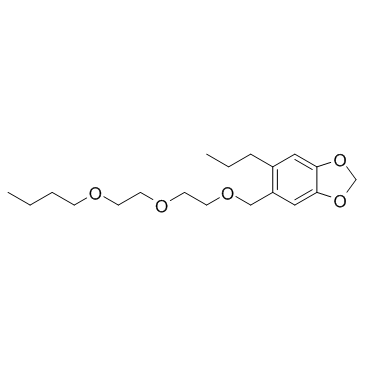Piperonyl butoxide

Piperonyl butoxide structure
|
Common Name | Piperonyl butoxide | ||
|---|---|---|---|---|
| CAS Number | 51-03-6 | Molecular Weight | 338.439 | |
| Density | 1.1±0.1 g/cm3 | Boiling Point | 396.2±0.0 °C at 760 mmHg | |
| Molecular Formula | C19H30O5 | Melting Point | N/A | |
| MSDS | Chinese USA | Flash Point | 165.3±27.2 °C | |
| Symbol |

GHS09 |
Signal Word | Warning | |
Use of Piperonyl butoxidePiperonyl butoxide is a semisynthetic derivative of safrole,used as a component of pesticide formulations. It is a synergist, despite having no pesticidal activity of its own, it enhances the potency of certain pesticides such as Carbamates, Pyrethrins, Pyrethroids, and Rotenone. |
| Name | piperonyl butoxide |
|---|---|
| Synonym | More Synonyms |
| Description | Piperonyl butoxide is a semisynthetic derivative of safrole,used as a component of pesticide formulations. It is a synergist, despite having no pesticidal activity of its own, it enhances the potency of certain pesticides such as Carbamates, Pyrethrins, Pyrethroids, and Rotenone. |
|---|---|
| Related Catalog |
| Density | 1.1±0.1 g/cm3 |
|---|---|
| Boiling Point | 396.2±0.0 °C at 760 mmHg |
| Molecular Formula | C19H30O5 |
| Molecular Weight | 338.439 |
| Flash Point | 165.3±27.2 °C |
| Exact Mass | 338.209320 |
| PSA | 46.15000 |
| LogP | 4.23 |
| Vapour Pressure | 0.0±0.8 mmHg at 25°C |
| Index of Refraction | 1.503 |
| InChIKey | FIPWRIJSWJWJAI-UHFFFAOYSA-N |
| SMILES | CCCCOCCOCCOCc1cc2c(cc1CCC)OCO2 |
| Stability | Stable. Combustible. Incompatible with oxidizing agents. |
| Water Solubility | <0.1 g/100 mL at 18 ºC |
CHEMICAL IDENTIFICATION
HEALTH HAZARD DATAACUTE TOXICITY DATA
MUTATION DATA
|
| Symbol |

GHS09 |
|---|---|
| Signal Word | Warning |
| Hazard Statements | H410 |
| Precautionary Statements | P273-P501 |
| Personal Protective Equipment | Eyeshields;Gloves |
| Hazard Codes | T:Toxic |
| Risk Phrases | R24;R51/53 |
| Safety Phrases | S60-S61-S45-S36/37/39-S28A |
| RIDADR | UN 3082 9/PG 3 |
| WGK Germany | 3 |
| RTECS | XS8050000 |
| Packaging Group | III |
| Hazard Class | 6.1(b) |
|
~74% 
Piperonyl butoxide CAS#:51-03-6 |
| Literature: Wang, Shuai; Liu, Jinqiang; Qian, Chao; Chen, Xinzhi Research on Chemical Intermediates, 2012 , vol. 38, # 1 p. 147 - 160 |
|
~% 
Piperonyl butoxide CAS#:51-03-6 |
| Literature: Schmidt; Dahm J. econ. Entomol., 1956 , vol. 49, p. 729,730 |
|
~% 
Piperonyl butoxide CAS#:51-03-6 |
| Literature: U.S. Ind. Chem. Inc. Patent: US2485680 , 1946 ; |
|
Sol-gel-based silver nanoparticles-doped silica – Polydiphenylamine nanocomposite for micro-solid-phase extraction.
Anal. Chim. Acta 886 , 56-65, (2015) A nanocomposite of silica-polydiphenylamine doped with silver nanoparticles (Ag-SiO2-PDPA) was successfully synthesized by the sol-gel process. For its preparation, PDPA was mixed with butanethiol cap... |
|
|
Cheminformatics analysis of assertions mined from literature that describe drug-induced liver injury in different species.
Chem. Res. Toxicol. 23 , 171-83, (2010) Drug-induced liver injury is one of the main causes of drug attrition. The ability to predict the liver effects of drug candidates from their chemical structures is critical to help guide experimental... |
|
|
Chlorantraniliprole susceptibility in Leptinotarsa decemlineata in the north Xinjiang Uygur autonomous region in China.
J. Econ. Entomol. 105(2) , 549-54, (2012) The Colorado potato beetle (Leptinotarsa decemlineata (Say)) in the north Xinjiang Uygur autonomous region has evolved resistance to various types of insecticides. Chlorantraniliprole is a novel anthr... |
| INCITE |
| 5-{[2-(2-Butoxyethoxy)ethoxy]methyl}-6-propyl-1,3-benzodioxole |
| Piperonylbutoxide |
| 2-(2-butoxyethoxy)ethyl 6-propylpiperonyl ether |
| Vex |
| 1,3-Benzodioxole, 5-[[2-(2-butoxyethoxy)ethoxy]methyl]-6-propyl- |
| Butacid |
| a-[2-(2-Butoxyethoxy)ethoxy]-4,5-methylenedioxy-2-propyltoluene |
| Pyrenon |
| 5-[2-(2-butoxyethoxy)ethoxymethyl]-6-propyl-1,3-benzodioxole |
| butocide |
| PBO |
| 5-{[(2-{[2-(butyloxy)ethyl]oxy}ethyl)oxy]methyl}-6-propyl-1,3-benzodioxole |
| Butylcarbityl (6-propylpiperonyl) ether |
| Toluene, α-[2- (2-butoxyethoxy)ethoxy]-4,5-(methylenedioxy)-2-propyl- |
| PRENTOX |
| 5-((2-(2-Butoxyethoxy)ethoxy)methyl)-6-propylbenzo[d][1,3]dioxole |
| Piperonyl butoxide |
| [3,4-(Methylenedioxy)-6-propylbenzyl] Butyl Diethyleneglycol Ether |
| EINECS 200-076-7 |
| piperonyl-butoxide |
| 2-(2-Butoxyethoxy)ethyl (6-propylpiperonyl) ether |
| fmc5273 |
| nia5273 |
| Butacide |
| MFCD00005842 |
| 6-Propylpiperonyl butyl diethylene glycol ether |
| 5-[[2-(2-Butoxyethoxy)ethoxy]methyl]-6-propyl-1,3-benzodioxole |
| 5-{[2-(2-butoxyethoxy)ethoxy]methyl}-6-propyl-2H-1,3-benzodioxole |




